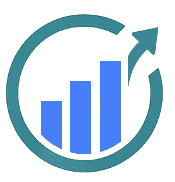Leveraging informal influencers using ONA allows change agents to adopt a more responsive and resilient change strategy. Once identified, informal influencers can be enlisted as “change champions” or advocates who promote the change message in their respective networks. By involving them in the early stages of planning and decision-making, change agents can leverage their natural authority and trusted positions, which has been shown to help foster buy-in and ease opposition across groups, teams, and departments..
There are two main types of networks that we are interested in identifying: cohesive networks and bridging networks. Cohesive networks are characterized by strong ties and high levels of trust among its members. These networks are more effective for implementing minor, nondivergent changes. The second type, bridging networks, connect disparate individuals and groups. Bridging networks are better suited for driving major, divergent changes that challenge existing norms and practices. Within these networks we find three principal actors: connectors, brokers, and energizers.

The primary influencer in a cohesive network is referred to as the connector. This is the person who sits in the middle of a network with multiple connections to others.
As mentioned, cohesive networks are best aligned for simpler, nondivergent changes because of the high levels of trust and support among members. This trust can facilitate more effective communication and coordination. In these networks, information and ideas are shared openly, leading to shared understanding and agreement. Since everyone is interconnected, individuals are more likely to behave consistently, knowing that discrepancies will be readily noticed. When working in a cohesive network, change agents can promote the benefits of a change with connectors. Within the network, most members will readily trust the intentions of other members, and even those who are hesitant will likely conform due to social pressure and the fact that the change will cause minimal disruption.
The primary influencer in the bridging network is referred to as a broker. Bridging networks are more effective for driving more complex, divergent changes because they offer access to novel information and perspectives from unconnected individuals and groups.
In these networks, change agents can control the flow of information and can tailor their message to different audiences, highlighting aspects relevant to each group’s needs and goals. This targeted approach is crucial for divergent changes as it prevents potential resisters from forming a unified opposition and allows the change agent to address concerns and build support strategically.
The third type of influencer is the energizer. Energizers are individuals who inspire and uplift others through their enthusiasm, positivity, and ability to promote engagement. They are pivotal in fostering momentum during change initiatives by spreading excitement and rallying others toward a shared purpose.
Energizers often exhibit high out-degree (numerous outbound links) centrality, meaning they influence a broad range of individuals across the organization. They can be, but are not always, central within a network. Look for highly connected individuals who bridge gaps between people, connecting those who otherwise may not show up as interacting with many others within the network. Equip energizers with clear messaging and tools to confidently communicate the purpose and goals of the change. Change agents should also regularly seek their input on the morale and receptiveness of teams, as they are often better attuned to emotional undercurrents. In addition, change agents can assign energizers visible roles in the change process where they can inspire others, such as leading team discussions or acting as ambassadors for the change. Finally, to maintain their enthusiasm and encourage others to emulate their behavior, publicly acknowledge their contributions and support.
Once your analysis is complete, it’s time to engage the influencers. That means meeting with them, understanding their perspective on the change, and seeking ways to influence their commitment. Informal influencers are well-positioned to gather honest feedback about how the change is perceived and where there may be push-back. Change agents can periodically consult with these influencers to understand emerging concerns or barriers, adjusting their strategies to address them more responsively. Remember, change is a contact sport. Only through connection and dialog can we hope to move the system in a positive direction.
What about naysayers? Can’t they also hold positions of informal influence? In the next installment, I will explore the negative side of informal influence and how these individuals might be brought into the change process.
